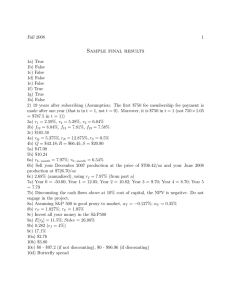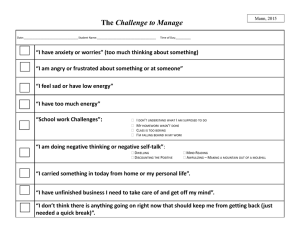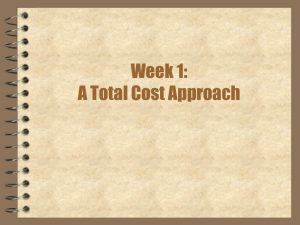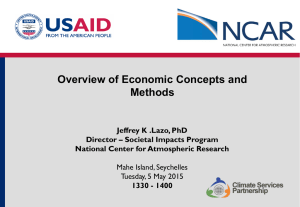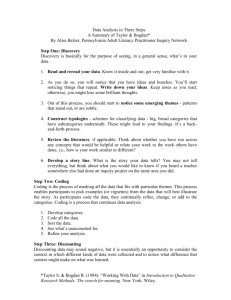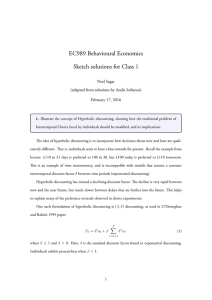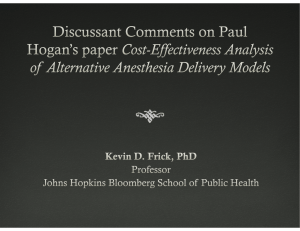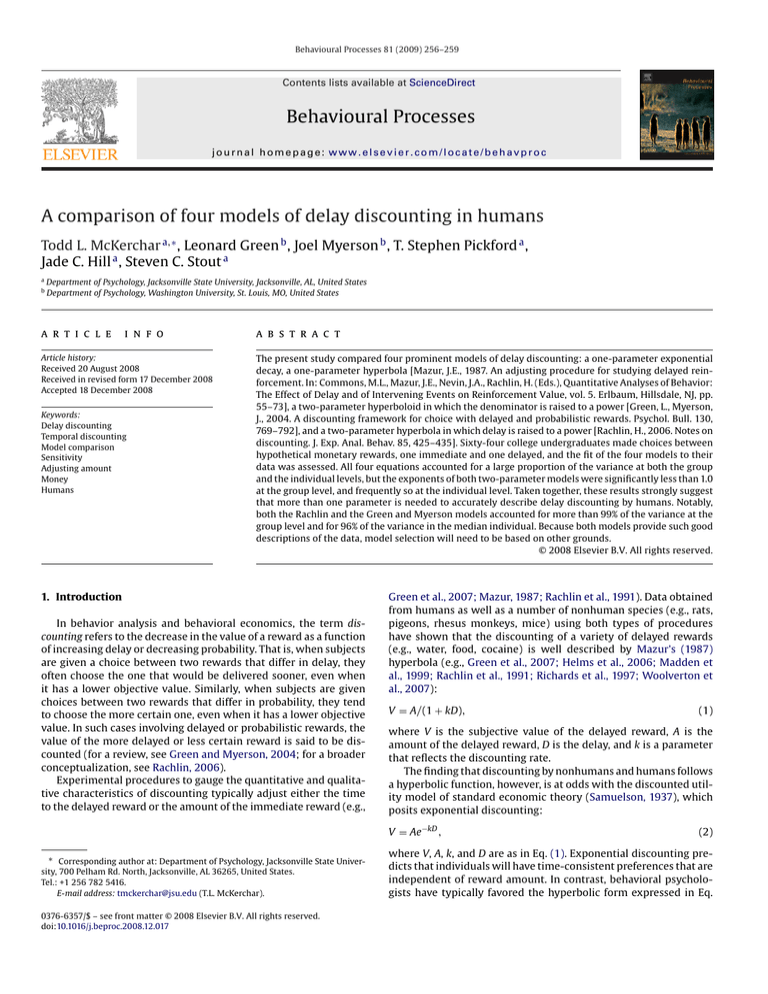
Behavioural Processes 81 (2009) 256–259
Contents lists available at ScienceDirect
Behavioural Processes
journal homepage: www.elsevier.com/locate/behavproc
A comparison of four models of delay discounting in humans
Todd L. McKerchar a,∗ , Leonard Green b , Joel Myerson b , T. Stephen Pickford a ,
Jade C. Hill a , Steven C. Stout a
a
b
Department of Psychology, Jacksonville State University, Jacksonville, AL, United States
Department of Psychology, Washington University, St. Louis, MO, United States
a r t i c l e
i n f o
Article history:
Received 20 August 2008
Received in revised form 17 December 2008
Accepted 18 December 2008
Keywords:
Delay discounting
Temporal discounting
Model comparison
Sensitivity
Adjusting amount
Money
Humans
a b s t r a c t
The present study compared four prominent models of delay discounting: a one-parameter exponential
decay, a one-parameter hyperbola [Mazur, J.E., 1987. An adjusting procedure for studying delayed reinforcement. In: Commons, M.L., Mazur, J.E., Nevin, J.A., Rachlin, H. (Eds.), Quantitative Analyses of Behavior:
The Effect of Delay and of Intervening Events on Reinforcement Value, vol. 5. Erlbaum, Hillsdale, NJ, pp.
55–73], a two-parameter hyperboloid in which the denominator is raised to a power [Green, L., Myerson,
J., 2004. A discounting framework for choice with delayed and probabilistic rewards. Psychol. Bull. 130,
769–792], and a two-parameter hyperbola in which delay is raised to a power [Rachlin, H., 2006. Notes on
discounting. J. Exp. Anal. Behav. 85, 425–435]. Sixty-four college undergraduates made choices between
hypothetical monetary rewards, one immediate and one delayed, and the fit of the four models to their
data was assessed. All four equations accounted for a large proportion of the variance at both the group
and the individual levels, but the exponents of both two-parameter models were significantly less than 1.0
at the group level, and frequently so at the individual level. Taken together, these results strongly suggest
that more than one parameter is needed to accurately describe delay discounting by humans. Notably,
both the Rachlin and the Green and Myerson models accounted for more than 99% of the variance at the
group level and for 96% of the variance in the median individual. Because both models provide such good
descriptions of the data, model selection will need to be based on other grounds.
© 2008 Elsevier B.V. All rights reserved.
1. Introduction
In behavior analysis and behavioral economics, the term discounting refers to the decrease in the value of a reward as a function
of increasing delay or decreasing probability. That is, when subjects
are given a choice between two rewards that differ in delay, they
often choose the one that would be delivered sooner, even when
it has a lower objective value. Similarly, when subjects are given
choices between two rewards that differ in probability, they tend
to choose the more certain one, even when it has a lower objective
value. In such cases involving delayed or probabilistic rewards, the
value of the more delayed or less certain reward is said to be discounted (for a review, see Green and Myerson, 2004; for a broader
conceptualization, see Rachlin, 2006).
Experimental procedures to gauge the quantitative and qualitative characteristics of discounting typically adjust either the time
to the delayed reward or the amount of the immediate reward (e.g.,
Green et al., 2007; Mazur, 1987; Rachlin et al., 1991). Data obtained
from humans as well as a number of nonhuman species (e.g., rats,
pigeons, rhesus monkeys, mice) using both types of procedures
have shown that the discounting of a variety of delayed rewards
(e.g., water, food, cocaine) is well described by Mazur’s (1987)
hyperbola (e.g., Green et al., 2007; Helms et al., 2006; Madden et
al., 1999; Rachlin et al., 1991; Richards et al., 1997; Woolverton et
al., 2007):
V = A/(1 + kD),
where V is the subjective value of the delayed reward, A is the
amount of the delayed reward, D is the delay, and k is a parameter
that reflects the discounting rate.
The finding that discounting by nonhumans and humans follows
a hyperbolic function, however, is at odds with the discounted utility model of standard economic theory (Samuelson, 1937), which
posits exponential discounting:
V = Ae−kD ,
∗ Corresponding author at: Department of Psychology, Jacksonville State University, 700 Pelham Rd. North, Jacksonville, AL 36265, United States.
Tel.: +1 256 782 5416.
E-mail address: tmckerchar@jsu.edu (T.L. McKerchar).
0376-6357/$ – see front matter © 2008 Elsevier B.V. All rights reserved.
doi:10.1016/j.beproc.2008.12.017
(1)
(2)
where V, A, k, and D are as in Eq. (1). Exponential discounting predicts that individuals will have time-consistent preferences that are
independent of reward amount. In contrast, behavioral psychologists have typically favored the hyperbolic form expressed in Eq.
T.L. McKerchar et al. / Behavioural Processes 81 (2009) 256–259
(1), which predicts time-inconsistent preferences as evidenced by
the well-established finding of preference reversals in both humans
and nonhumans (e.g., Ainslie and Haendel, 1983; Green et al., 1981,
1994; for more on this issue, see Ainslie, 1975; Green and Myerson,
1993).
With humans, Eq. (1) tends to overpredict subjective value at
shorter delays, while underpredicting it at longer delays (Green
and Myerson, 2004; see, e.g., Odum et al., 2006). As a result, alternative models have been proposed to more adequately describe
the discounting of delayed rewards by humans. Perhaps the most
prominent alternative model of discounting is a generalized form
of Eq. (1) described by Myerson and Green (1995):
s
V = A/(1 + kD) .
(3)
In this equation, s is a free parameter that may reflect individual
differences in the scaling of delay and/or amount (Green et al., 1994;
Myerson and Green, 1995). Note that when s = 1.0, Eq. (3) reduces
to Eq. (1). When s is less than 1.0, however, subjective value is more
sensitive to changes at shorter delays and less sensitive to changes
at longer delays than is predicted by Eq. (1) (for earlier discussions
of Eq. (3), see Loewenstein and Prelec, 1992; Rachlin, 1989).
Because Eq. (3), a two-parameter model, will almost always provide a better fit than a one-parameter model, statistical procedures
are used to assess whether the relative complexity of Eq. (3) is necessary when describing discounting by humans. One approach has
been to determine whether the proportion of variance accounted
for (R2 ) by Eq. (3) is significantly greater than that of Eqs. (1) and
(2). A second approach has been to test whether the s parameter
of Eq. (3) deviates significantly from 1.0 (e.g., Myerson and Green,
1995; Simpson and Vuchinich, 2000). Significant deviations from
an s value of 1.0 suggest the need for the more general form of
hyperbolic discounting represented by Eq. (3). Overall, the results
obtained using these approaches at both the individual and group
level indicate that a hyperboloid model of the form of Eq. (3) often
describes the discounting of various rewards displayed by humans
more accurately than does Eq. (1) (e.g., Green et al., 1999; Myerson
and Green, 1995; Simpson and Vuchinich, 2000).
Rachlin (2006) has proposed a different two-parameter model
of discounting. His model is similar to Mazur’s (1987) hyperbola
except that delay is raised to a power (see also, Rodriguez and Logue,
1988):
V = A/(1 + kDs ).
(4)
Like Eq. (3), Rachlin’s power function form of hyperbolic discounting is derived explicitly from Stevens’s (1957) psychophysical
power law. According to Rachlin, the s parameter reflects the sensitivity of subjective value to the variable D, delay. Rachlin found that
both Eqs. (3) and (4) accounted for a similarly high proportion of
the variance in delay discounting data at the group level for various
magnitudes ($100, $1000, and $1,000,000) of delayed gains (R2 s of
.99).
Although Rachlin (2006) compared the fits of Eqs. (3) and (4) to
group median data, the ability of these models to describe data at
the individual level has not been compared. A good model of discounting should not only be able to describe the aggregate behavior
of any particular group, but should also accurately describe the
behavior of the individuals in that group (Green and Myerson, 2004;
see Estes, 1956; Sidman, 1952). Accordingly, the major aim of the
present work was to compare the two hyperboloid models of delay
discounting, Eq. (3) (Green and Myerson, 2004) and Eq. (4) (Rachlin,
2006), at the individual as well as the group level. It has been shown
that Eq. (3) provides a better description than Eq. (1) of the data from
many, but not all individuals (e.g., Myerson et al., 2003). However,
the proportion of individuals for whom Eq. (4) provides a better
description than Eq. (1) is not known. Eq. (2) was studied because
257
of its status in standard economic theory as a normative model of
intertemporal choice.
2. Materials and methods
2.1. Participants
Sixty-four participants (41 female) were recruited from an introductory psychology course at a regional university in Northeast
Alabama. The average age and education (and standard deviation) of
the participants was 21.6 (±3.8) and 12.6 (±0.9) years, respectively.
The ethnic breakdown was 61% Caucasian, 33% African-American,
and 6% Hispanic or Other. There were no eligibility criteria and participation was voluntary. Participants were tested individually in a
quiet room. The university’s Institutional Review Board approved
study procedures prior to their conduct.
2.2. Procedure
Participants sat in front of a desktop computer that presented
them with a series of choices between a smaller, immediate and a
larger, delayed hypothetical monetary gain. An adjusting-amount
procedure was used. In each series of choices, the amount of the
larger, later reward and the delay until its receipt were held constant (e.g., $1000 in 1 year). The smaller, immediate reward was
adjusted according to a “double-limit” algorithm (see Richards et al.,
1999) until it converged on an immediate amount that was deemed
subjectively equivalent to the larger, later reward (i.e., the participant was relatively indifferent between them). Then the delay to
the larger, later reward was changed, and the smaller, immediate
reward was repeatedly adjusted again until another indifference
point was determined. This procedure was repeated for each of
seven delays (1 day, 1 week, 1 month, 6 months, 1 year, 5 years, and
25 years), which were studied in ascending order. The larger, later
amount was always $1000, and the smaller, immediate amounts
ranged from $40 to $960.
2.3. Data analysis
The amount of immediate money judged equal in subjective
value to the $1000 delayed amount was expressed as a proportion of
the objective value of the delayed amount. Eqs. (1) through (4) were
fit to the individual and group data using nonlinear regression techniques (GraphPad Prism® ), which provided appropriate parameter
estimates and R2 values. A t-ratio statistic was used to determine
whether the s values in Eqs. (3) and (4) deviated significantly from
1.0. Specifically, the estimate of s was subtracted from 1.0, and then
divided by the standard error of s. The resulting t ratio has (n–p)
degrees of freedom where n is the number of data points and p is
the number of model parameters (Myerson and Green, 1995). To
assess whether the fits at the individual level differed significantly
between equations with the same number of parameters (i.e., Eq.
(1) vs. Eq. (2), and Eq. (3) vs. Eq. (4)), the R2 values were subjected
to Wilcoxon signed-rank tests.
3. Results
The top panel of Fig. 1 shows the median indifference points and
the best-fitting discounting functions for Eqs. (1) through (4). The
data appear to be relatively well described by all four equations,
but compared with the one-parameter exponential and hyperbolic
equations (Eqs. (1) and (2), respectively), the two-parameter equations (i.e., Eqs. (3) and (4)) provide visually superior fits to the
median data. The bottom panel of Fig. 1 depicts the same data, but
the x-axis is scaled logarithmically to provide more detail of the fit at
258
T.L. McKerchar et al. / Behavioural Processes 81 (2009) 256–259
Fig. 1. Subjective value expressed as a proportion of the $1,000 delayed amount. The
top panel shows the four delay discounting functions (Eqs. (1) through (4)) fit to the
median indifference points. The bottom panel shows the same data and functions,
but the x-axis is scaled logarithmically to provide more detail at the shorter delays.
the shorter delays. As may be seen, both of the one-parameter equations (and especially Eq. (2)) overestimate the indifference points
at the shorter delays and underestimate them at the longer delays.
In contrast, neither of the two-parameter equations exhibited such
systematic bias.
Table 1 shows the parameter values and R2 s for the discounting
functions fit to the group median data depicted in Fig. 1, as well as
(in italics) the median parameter values and R2 s based on fits of the
discounting functions to individual data. With respect to the fits to
the data shown in Fig. 1, the values of the s parameter for Eqs. (3) and
(4) (0.45 and 0.67) both were significantly less than 1.0; t(5) = 8.55,
and t(5) = 16.10, respectively, both ps < .01. At the individual level,
the value of the s parameter in Eq. (3) differed significantly from 1.0
in 37 (58%) of the 64 cases, all t(5)s > 2.57, ps < .05, and was significantly less than 1.0 in all but one of these 37 cases; the value of the
s parameter in Eq. (4) differed significantly from 1.0 in 40 (63%) of
Table 1
Parameter estimates and fit statistics for the discounting functions (Eqs. (1) through
(4)). Values in regular font are based on fits to the group median data depicted in
Fig. 1; values in italics are the medians based on fits to individual data.
Discounting equation
k
s
R2
Eq. (1) (hyperbolic)
0.0062
0.0069
–
–
.967
.929
Eq. (2) (exponential)
0.0037
0.0038
–
–
.911
.892
Eq. (3) (Green and Myerson)
0.0281
0.0423
0.45
0.42
.992
.956
Eq. (4) (Rachlin)
0.0346
0.0435
0.67
0.66
.999
.963
Note: Dashes indicate parameter was not applicable to the particular equation.
the 64 cases, all t(5)s > 2.57, ps < .05, and was significantly less than
1.0 in 34 of these 40 cases.
In terms of variance accounted for, all four discounting models provided good-to-excellent fits to the group median data (see
Table 1). The one-parameter models both accounted for a high proportion of the variance, but Eq. (1) accounted for notably more
variance than did Eq. (2) (R2 = .967 and .911, respectively). Not surprisingly, the two-parameter models, Eqs. (3) and (4), both provided
even better fits to the median data (R2 = .992 and .999, respectively).
With respect to fits at the individual level, in many cases the
one-parameter models did not provide a better description of an
individual’s data than did the mean of that individual’s subjective
values (i.e., the sum of the squared residuals was greater than the
variance about the mean of the individual’s subjective values for
the different delays). Specifically, the hyperbolic equation (Eq. (1))
provided a poorer description than the mean of the individual’s
subjective values in 10 cases (16%), and the exponential equation
(Eq. (2)) provided a poorer description than the mean in 14 cases
(22%). With regard to the two-parameter models, in contrast, there
was only one case in which Eq. (3) fared worse than an individual’s
mean, and there were no cases in which Eq. (4) accounted for less
variance than an individual’s mean.
Comparing the one-parameter models, the R2 for Eq. (1) was
higher than that for Eq. (2) in 43 (67%) of the 64 participants, and
the difference between these models was significant according to a
Wilcoxon signed-rank test (p < .01). Comparing the two-parameter
models, Eq. (4) accounted for more variance than did Eq. (3) in
slightly more than half (53%) of the cases, and the difference
between these models was not significant according to a Wilcoxon
signed-rank test.
4. Discussion
The primary aim of the present study was to compare the ability of four different models to describe the discounting of delayed
monetary rewards at both the group and individual levels. With
regard to the one-parameter models, the data clearly supported the
simple hyperbola (Mazur, 1987) over an exponential model at the
group level and in a substantial majority of the participants. These
results are consistent with prior findings that call into question the
adequacy of exponential discounting as an appropriate model of
intertemporal choice (e.g., Kirby and Herrnstein, 1995; Madden et
al., 1999; Myerson and Green, 1995).
The present results also are consistent with a growing number
of studies indicating that an additional sensitivity parameter often
is warranted when describing delay discounting by human participants. With both the Green and Myerson model, Eq. (3), and the
Rachlin model, Eq. (4), we found that s deviated significantly from
1.0 in the majority of individual participants as well as at the group
level. With respect to Eq. (3), these results are consistent with previous findings (e.g., Green and Myerson, 2004; Myerson et al., 2003;
Myerson and Green, 1995; Simpson and Vuchinich, 2000). With
respect to Eq. (4), the present results replicate Rachlin’s (2006) findings regarding delay discounting at the group level and are the first
to support his model at the individual level.
Notably, when s was significantly different from 1.0, it was less
than 1.0 in all but one case with Eq. (3), and in 85% of the cases
with Eq. (4). Whether s is greater or less than 1.0 is important from
a theoretical perspective, particularly that of the Rachlin (2006)
model. This is because the s parameter in the Rachlin model represents the exponent of the power function that scales delay, and
previous studies have shown that the relation between subjective
and objective time is negatively accelerated, particularly over the
range studied here (e.g., Zauberman et al., in press). Therefore, the
exponent in the power function component of Eq. (4) should be
less than 1.0, as indeed it was in the majority of cases when Eq. (4)
T.L. McKerchar et al. / Behavioural Processes 81 (2009) 256–259
was fit to the data from individual participants. With respect to the
Green and Myerson model, the s parameter represents the exponent of the power function scaling time divided by the exponent
of the power function scaling amount (Myerson and Green, 1995).
Although both exponents would be expected to be less than 1.0 in
this model, there is no basis for predicting which is smaller, particularly at the individual level. Nevertheless, the finding that s < 1.0 is
important because it implies that the exponent of the power function scaling time is typically less than the exponent of the power
function scaling amount.
Rachlin (2006) found that that there was little difference in R2
between Eqs. (3) and (4) at the group level, and our results replicate this finding and extend it to delay discounting by individual
participants. Thus, our results support Rachlin’s contention that it
may be difficult to distinguish between these models solely on the
basis of their fits to data. Instead, one may need to choose a model
based on theoretical reasons, rather than empirical ones.
Rachlin (2006) pointed out that the extent to which models fit
into a larger theoretical network provides an important basis for
their evaluation. In this context, he showed that the generalized
matching law (Baum, 1974) and a form of utility maximization could
be rewritten in the hyperboloid form of Eq. (4). It should be noted,
however, that Eq. (3) also is consistent with the matching law. In
contrast to Baum’s equation, Eq. (3) yields a form of generalized
matching in which amount and delay have separate exponents.
This is because Myerson and Green’s (1995) derivation of Eq. (3)
assumes that Stevens’s power law describes the scaling of amount
as well as time. Indeed, utility functions, which describe the relation between value and amount, are generally assumed to be well
described by power functions. Thus, both Eq. (3) and Eq. (4) have
the desirable attribute of fitting into larger theoretical networks,
and future work will be needed to determine an appropriate basis
for choosing between them.
Acknowledgements
The authors thank Bill Palya for his helpful comments on and discussion of this manuscript, and Makenzie Williams for her help with
data collection. Jade Hill is now at Arizona State University. Preparation of the article was supported in part by National Institutes of
Health Grant MH55308 to Leonard Green and Joel Myerson.
References
Ainslie, G., 1975. Specious reward: a behavioral theory of impulsiveness and impulse
control. Psychol. Bull. 82, 463–496.
Ainslie, G., Haendel, V., 1983. The motives of the will. In: Gottheil, E., Druley, K.A.,
Skodola, T.E., Waxman, H.M. (Eds.), Etiologic Aspects of Alcohol and Drug Abuse.
Charles C. Thomas, Springfield, IL, pp. 119–140.
259
Baum, W.M., 1974. On two types of deviation from the matching law: bias and
undermatching. J. Exp. Anal. Behav. 22, 231–242.
Estes, W.K., 1956. The problem of inference from curves based on group data. Psychol.
Bull. 53, 134–140.
Green, L., Fisher Jr., E.B., Perlow, S., Sherman, L., 1981. Preference reversal and selfcontrol: choice as a function of reward amount and delay. Behav. Anal. Lett. 1,
43–51.
Green, L., Fry, A., Myerson, J., 1994. A life-span comparison. Psychol. Sci. 5, 33–36.
Green, L., Myerson, J., 1993. Alternative frameworks for the analysis of self control.
Behav. Philos. 21, 37–47.
Green, L., Myerson, J., 2004. A discounting framework for choice with delayed and
probabilistic rewards. Psychol. Bull. 130, 769–792.
Green, L., Myerson, J., Ostaszewski, P., 1999. Amount of reward has opposite effects
on the discounting of delayed and probabilistic outcomes. J. Exp. Psychol.: Learn.
Mem. Cogn. 25, 418–427.
Green, L., Myerson, J., Shah, A.K., Estle, S.J., Holt, D.D., 2007. Do adjusting-amount and
adjusting-delay procedures produce equivalent estimates of subjective value in
pigeons? J. Exp. Anal. Behav. 87, 337–347.
Helms, C.M., Reeves, J.M., Mitchell, S.H., 2006. Impact of strain and d-amphetamine
on impulsivity (delay discounting) in inbred mice. Psychopharmacology 188,
144–151.
Kirby, K., Herrnstein, R., 1995. Preference reversals due to myopic discounting of
delayed reward. Psychol. Sci. 6, 83–89.
Loewenstein, G., Prelec, D., 1992. Anomalies in intertemporal choice: evidence and
an interpretation. Q. J. Econ. 107, 573–597.
Madden, G.J., Bickel, W.K., Jacobs, E.A., 1999. Discounting of delayed rewards in
opioid-dependent outpatients: exponential or hyperbolic discounting functions? Exp. Clin. Psychopharmacol. 7, 284–293.
Mazur, J.E., 1987. An adjusting procedure for studying delayed reinforcement. In:
Commons, M.L., Mazur, J.E., Nevin, J.A., Rachlin, H. (Eds.), Quantitative Analyses
of Behavior: The Effect of Delay and of Intervening Events on Reinforcement
Value, vol. 5. Erlbaum, Hillsdale, NJ, pp. 55–73.
Myerson, J., Green, L., 1995. Discounting of delayed rewards: models of individual
choice. J. Exp. Anal. Behav. 64, 263–276.
Myerson, J., Green, L., Hanson, J.S., Holt, D.D., Estle, S.J., 2003. Discounting delayed
and probabilistic rewards: processes and traits. J. Econ. Psychol. 24, 619–635.
Odum, A.L., Baumann, A.A., Rimington, D.D., 2006. Discounting of delayed hypothetical money and food: effects of amount. Behav. Process. 73, 278–284.
Rachlin, H., 1989. Judgment, Decision, and Choice: A Cognitive/Behavioral Synthesis.
W.H. Freeman, New York.
Rachlin, H., 2006. Notes on discounting. J. Exp. Anal. Behav. 85, 425–435.
Rachlin, H., Raineri, A., Cross, D., 1991. Subjective probability and delay. J. Exp. Anal.
Behav. 55, 233–244.
Richards, J.B., Mitchell, S.H., De Wit, H., Seiden, L.S., 1997. Determination of discount
functions in rats with an adjusting-amount procedure. J. Exp. Anal. Behav. 67,
353–366.
Richards, J.B., Zhang, L., Mitchell, S.H., De Wit, H., 1999. Delay or probability discounting in a model of impulsive behavior: effect of alcohol. J. Exp. Anal. Behav.
71, 121–143.
Rodriguez, M.L., Logue, A.W., 1988. Adjusting delay to reinforcement: comparing
choice in pigeons and humans. J. Exp. Psychol.: Anim. Behav. Process. 14, 105–117.
Samuelson, P.A., 1937. A note on measurement of utility. Rev. Econ. Stud. 4, 155–161.
Sidman, M., 1952. A note on functional relations obtained from group data. Psychol.
Bull. 49, 263–269.
Simpson, C., Vuchinich, R., 2000. Reliability of a measure of temporal discounting.
Psychol. Rec. 50, 3–16.
Stevens, S.S., 1957. On the psychophysical law. Psychol. Rev. 64, 153–181.
Woolverton, W.L., Myerson, J., Green, L., 2007. Delay discounting of cocaine by rhesus
monkeys. Exp. Clin. Psychopharmacol. 15, 238–244.
Zauberman, G., Kim, B.K., Malkoc, S.A., Bettman, J.R., in press. Discounting time and
time discounting: subjective time perception and intertemporal preferences. J.
Market. Res.

